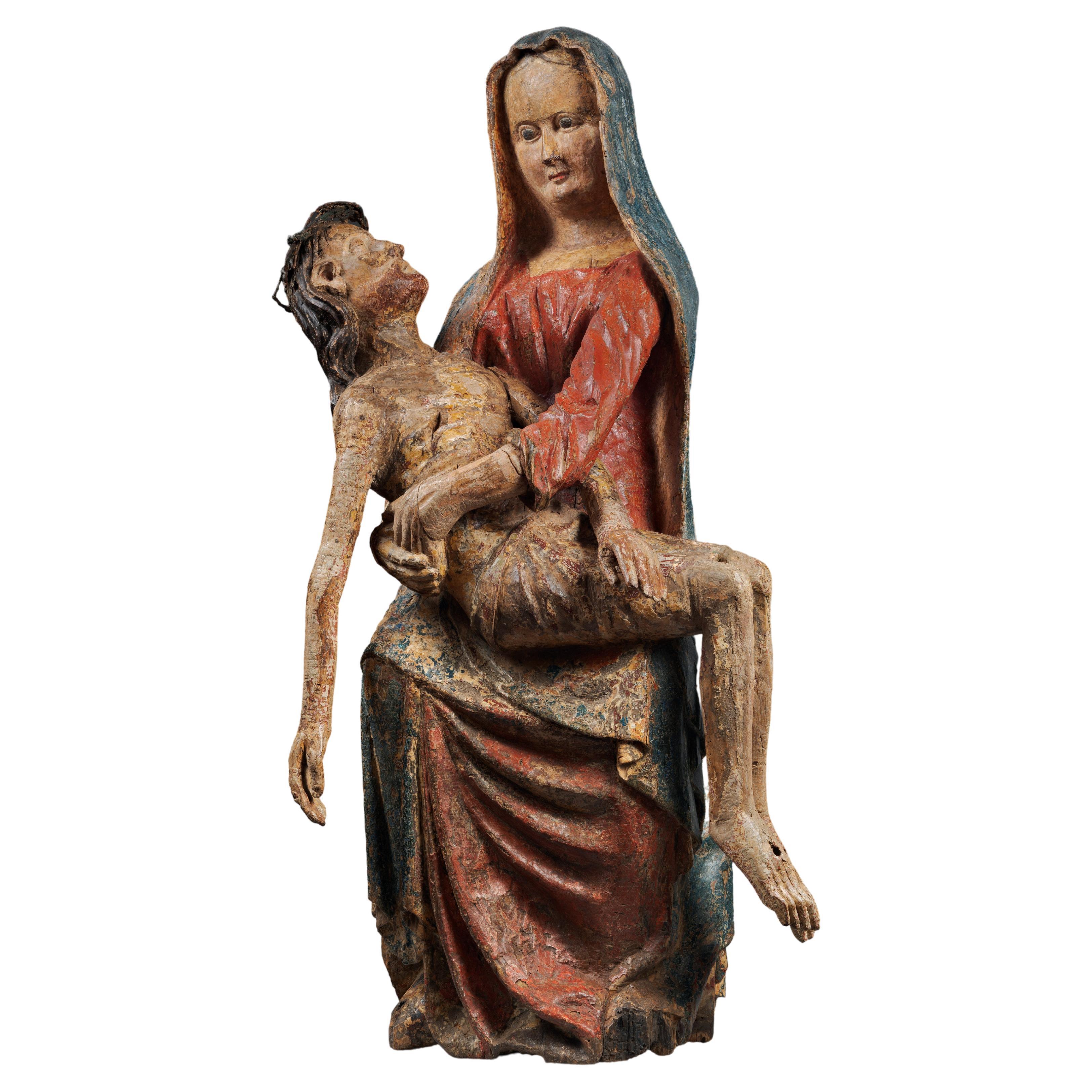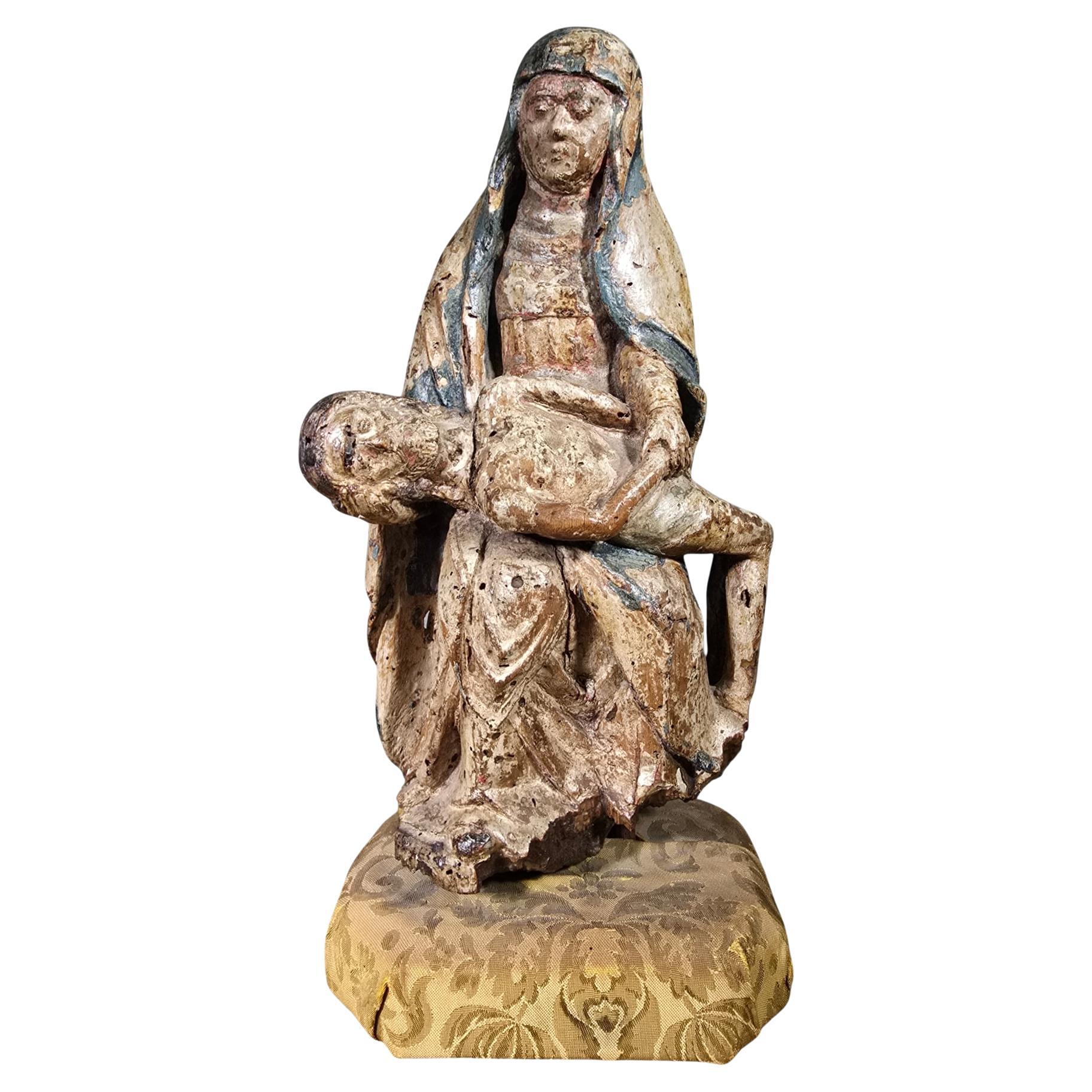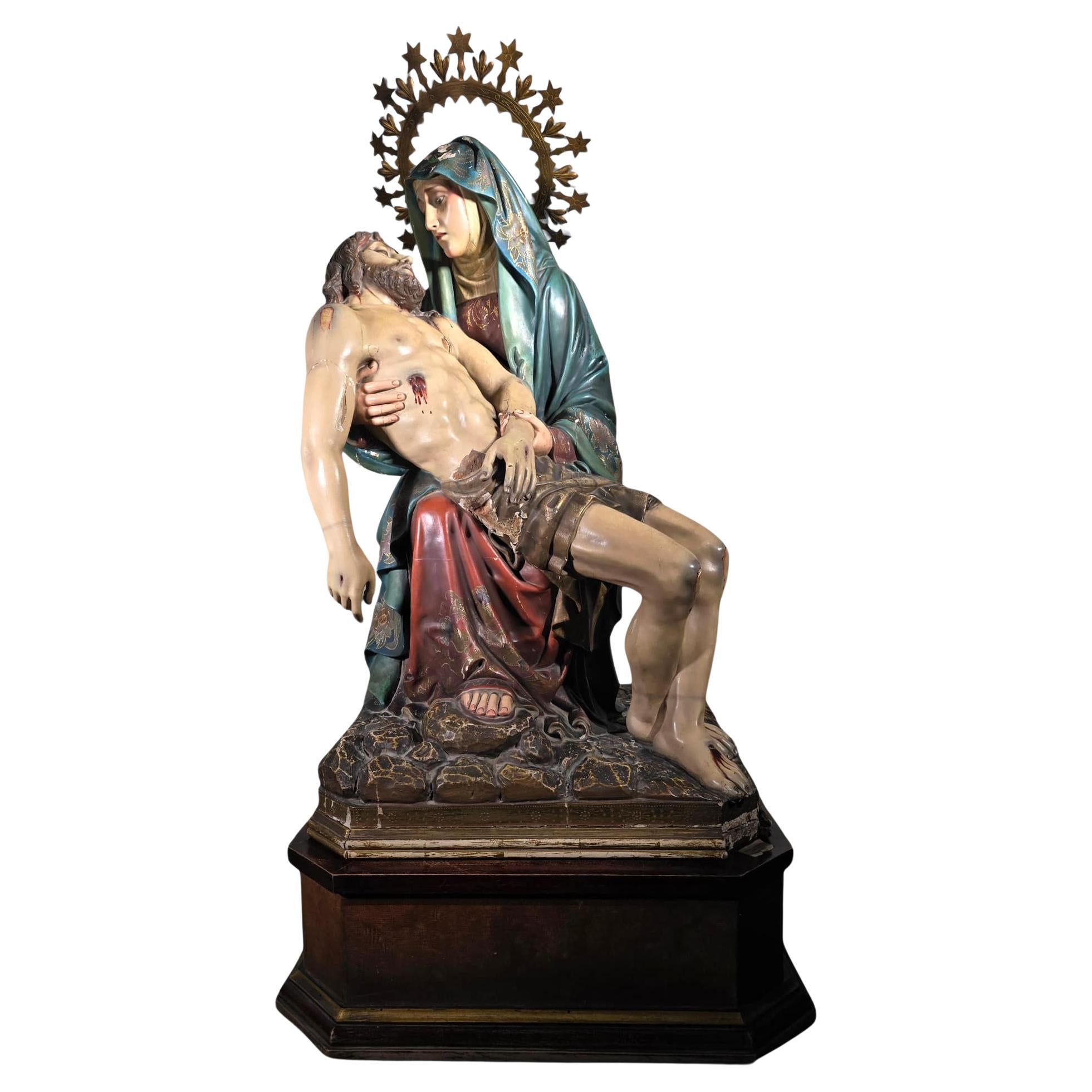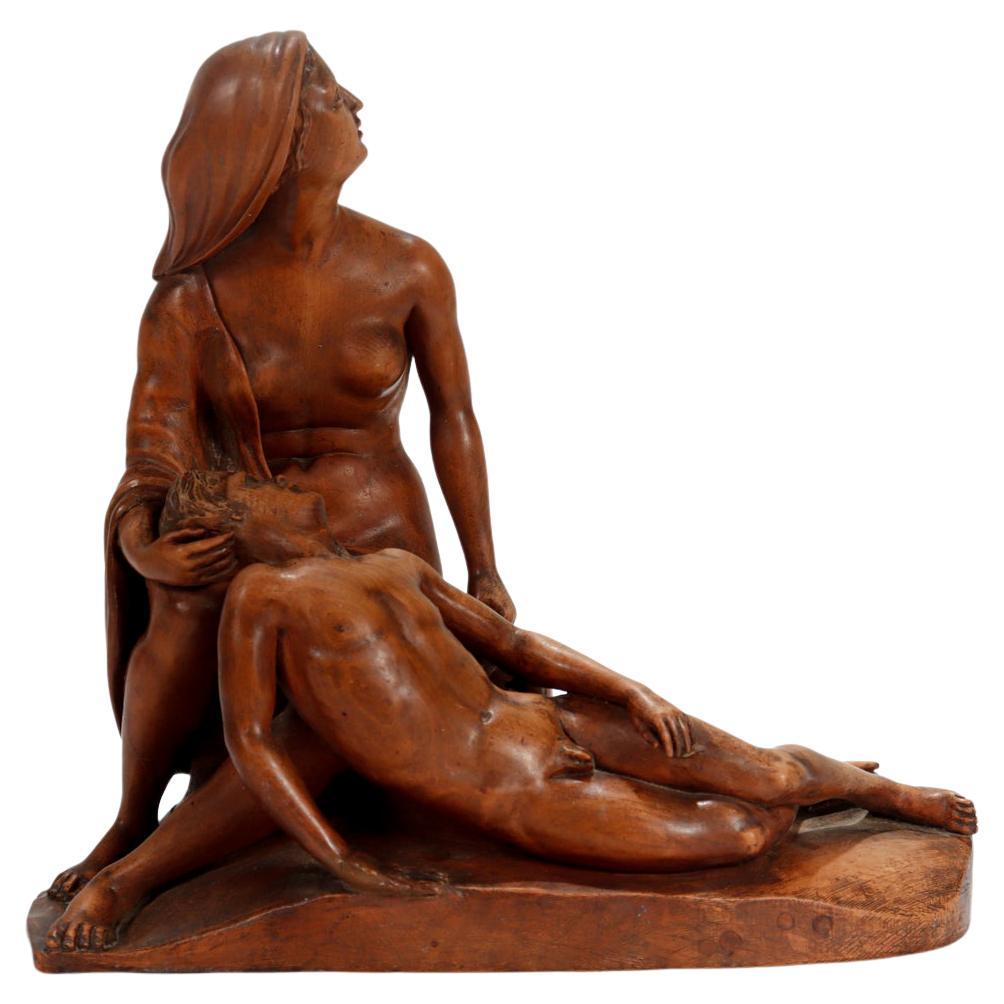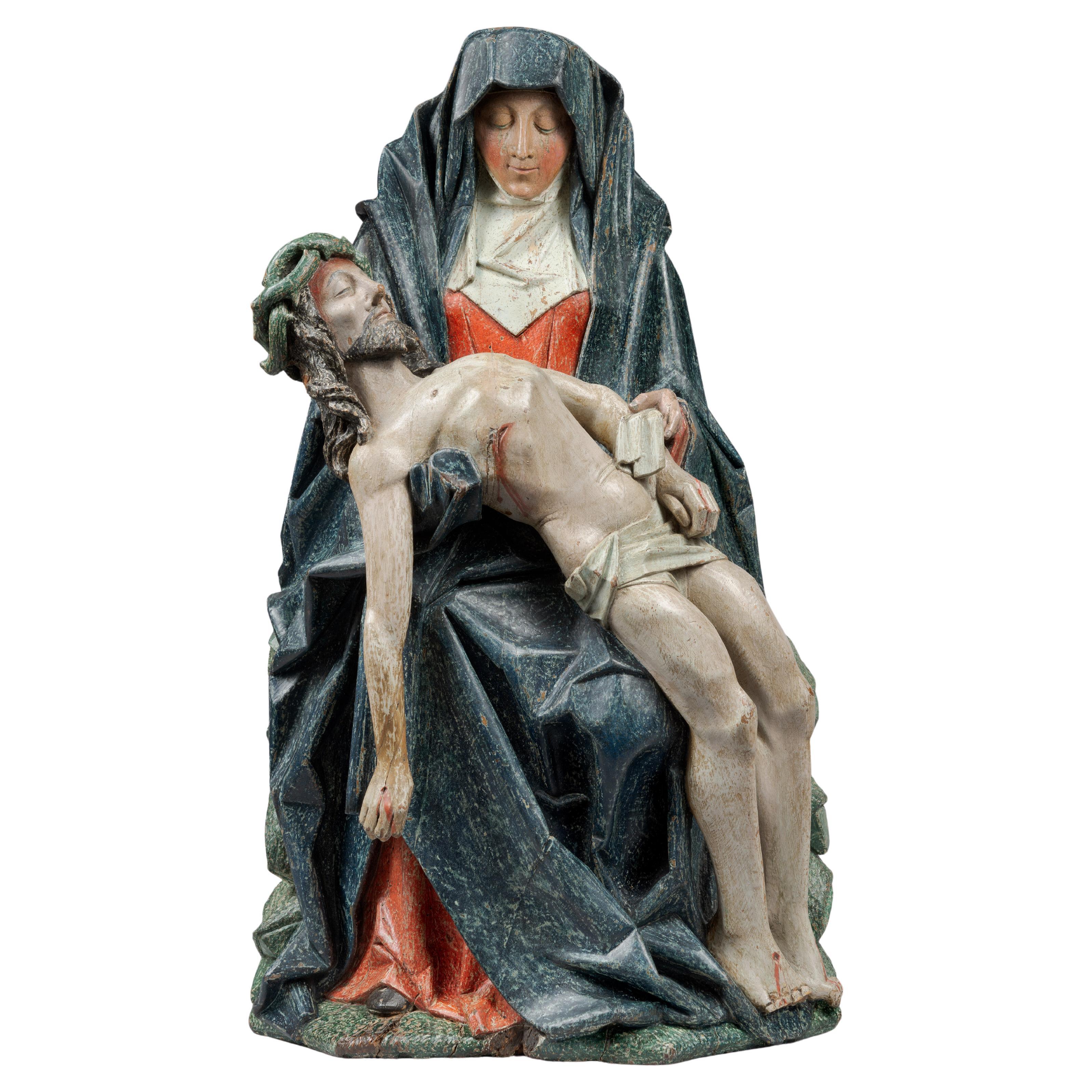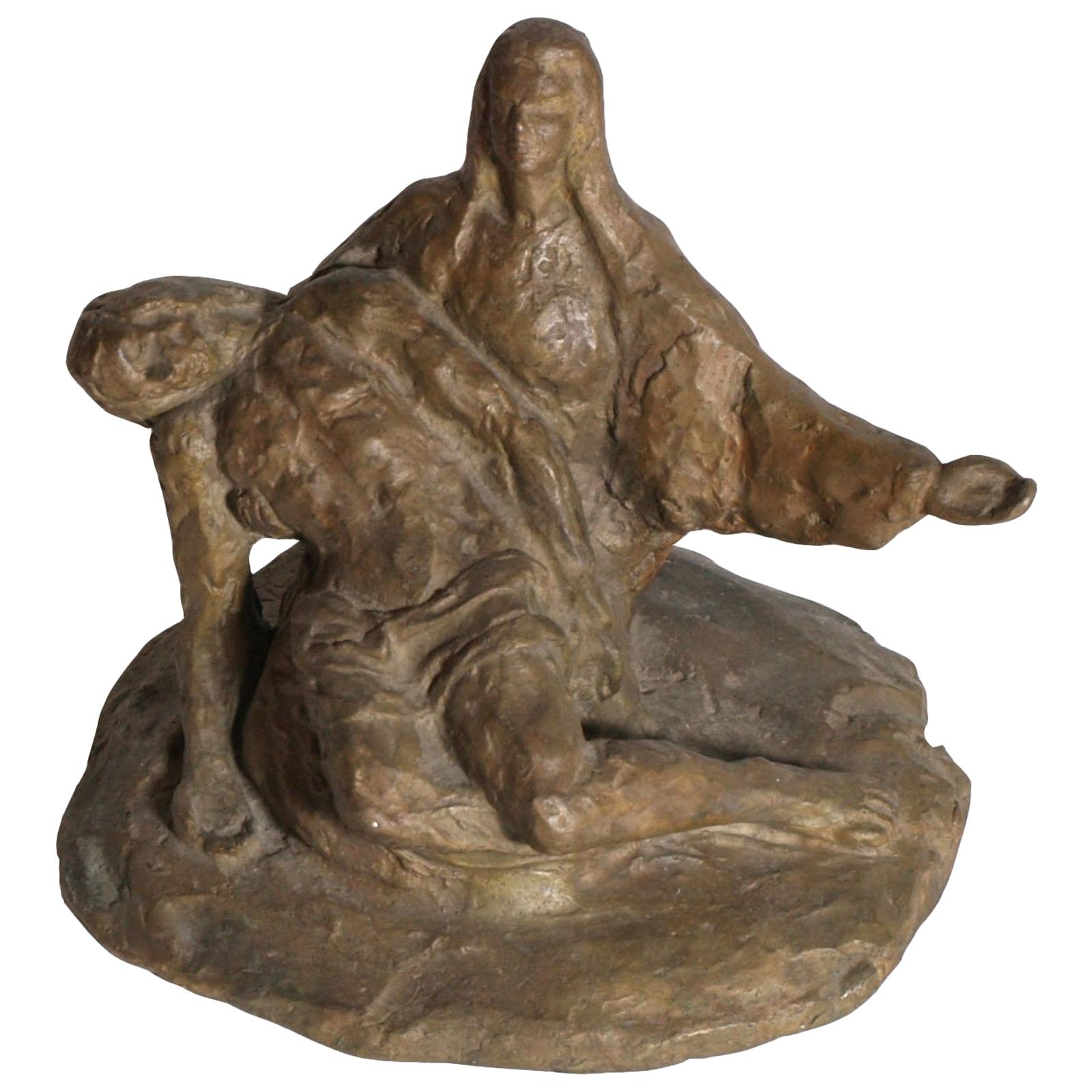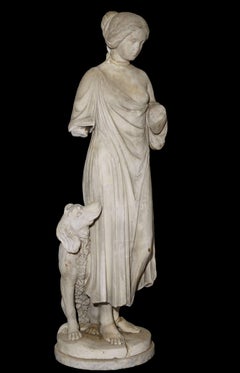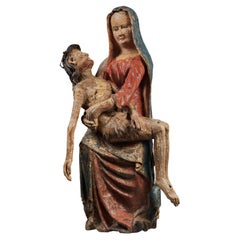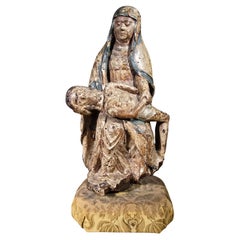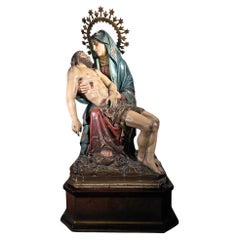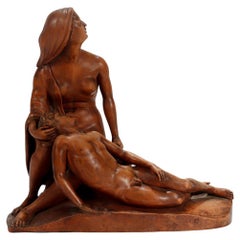Items Similar to Pieta Lime Wood Sculpture Franco Burgundian late 15th century
Want more images or videos?
Request additional images or videos from the seller
1 of 8
UnknownPieta Lime Wood Sculpture Franco Burgundian late 15th centuryunfamiliar
unfamiliar
$4,298.01
£3,169.74
€3,600
CA$5,940.50
A$6,606.23
CHF 3,467.39
MX$80,559.83
NOK 43,820.92
SEK 41,083.86
DKK 27,407.36
About the Item
Beautiful linden wood carving depicting a Pieta. France, Burgundian-Flemish current, late 15th to early 16th century. This theme is not found in the Bible but is derived from apocryphal stories. It depicts the moment before the Deposition from the Cross, when the Virgin Mary holds the lifeless body of Jesus. This scene differs from the Lamentation of Christ in which other characters are present. The iconography of the Virgin of Pity spread throughout Europe at the end of the Middle Ages: the first appearances of the theme occurred in the 14th century in Germany, while in France and northern regions it appeared in the 15th and 16th centuries. But it was in Italy that the theme reached its zenith with Michelangelo's famous Pieta, made in 1499 and displayed in St. Peter's Basilica in Rome. In France the iconography of the Virgin of Pity was very successful, particularly in Burgundy, where numerous examples can still be found today. Unlike the Nordic and Germanic versions, in which the theme focuses especially on tragedy and grief, the Burgundian version focuses rather on the theme of dignified resignation. The refinement of execution, less rigid than the Germanic models, is also very reminiscent of Burgundian sculpture. The Virgin is depicted wearing the wimple, which was very common in France during the medieval period, suggesting that the work still dates from the 15th century.
Measurements H cm 55 Base 35 x 20 cm
- Creation Year:unfamiliar
- Dimensions:Height: 21.66 in (55 cm)Width: 13.78 in (35 cm)Depth: 7.88 in (20 cm)
- Medium:
- Movement & Style:Northern Renaissance
- Period:
- Condition:
- Gallery Location:Pistoia, IT
- Reference Number:1stDibs: LU2746216306092
About the Seller
4.5
Vetted Professional Seller
Every seller passes strict standards for authenticity and reliability
Established in 1997
1stDibs seller since 2024
16 sales on 1stDibs
- ShippingRetrieving quote...Shipping from: PISTOIA, Italy
- Return Policy
Authenticity Guarantee
In the unlikely event there’s an issue with an item’s authenticity, contact us within 1 year for a full refund. DetailsMoney-Back Guarantee
If your item is not as described, is damaged in transit, or does not arrive, contact us within 7 days for a full refund. Details24-Hour Cancellation
You have a 24-hour grace period in which to reconsider your purchase, with no questions asked.Vetted Professional Sellers
Our world-class sellers must adhere to strict standards for service and quality, maintaining the integrity of our listings.Price-Match Guarantee
If you find that a seller listed the same item for a lower price elsewhere, we’ll match it.Trusted Global Delivery
Our best-in-class carrier network provides specialized shipping options worldwide, including custom delivery.More From This Seller
View AllAltorilievo in Marmo della Montagnola Senese Profilo Siena XIV secolo
Located in Pistoia, IT
Altorilievo in marmo della Montagnola Senese raffigurante un profilo femminile a mezzo busto, Siena, XIV secolo.
L'altorilievo, nella tradizione senese del XIV secolo, si caratter...
Category
15th Century and Earlier Medieval Figurative Sculptures
Materials
Marble
Large Italian Neoclassical Marble Sculpture Allegory 18th century
Located in Pistoia, IT
Impressive neoclassical Carrara marble sculpture depicting the Allegory of Friendship and Loyalty, second half of the 18th century.
The sculpture depicts Friendship as a classical ...
Category
Late 18th Century Italian School Figurative Sculptures
Materials
Marble
Madonna and Child, Polychrome Stucco Relief, workshop of Luca della Robbia.
Located in Pistoia, IT
Madonna and Child, polychrome stucco relief, workshop of Luca della Robbia. Second half of the 15th century.
Modeled as half-length, the Child holds his mother's veil in one hand, th...
Category
15th Century and Earlier Medieval Figurative Sculptures
Materials
Other Medium
Great Renaissance Serene Stone Sculpture of Greyhound Florence 16th century
Located in Pistoia, IT
16th-century Florentine sculptor, greyhound in pietra serena.
This fascinating sculpture, which has come down to us in fragmentary form, depicts a dog, an elegant greyhound crouching...
Category
16th Century Renaissance Figurative Sculptures
Materials
Stone
French School of the 17th century Large Group in Terracotta
Located in Pistoia, IT
Large terracotta group depicting interior scene, northern France, second half of the 17th century.
The fine execution of this delightful family interior takes us back to the product...
Category
Late 17th Century Baroque Figurative Sculptures
Materials
Terracotta
Large Neoclassical White Marble Sculpture Venus Italica mid-19th century
Located in Pistoia, IT
Venus Italica, imposing sculpture in white Carrara marble, mid-nineteenth-century Roman atelier.
Antonio Canova made several sculptures depicting Venus. The first was made as compen...
Category
Mid-19th Century Italian School Figurative Sculptures
Materials
Marble
You May Also Like
Important German Pietà from the, 14th Century
Located in Saint-Ouen, FR
IMPORTANT GERMAN PIETÀ FROM THE 14th CENTURY
ORIGIN: GERMANY, REGION DE COLOGNE
PERIOD: BEGINNING IF THE 14th CENTURY, ca. 1330
Height: 98 cm
Length: 45 cm
Depth: 33 cm
Polychromed linden wood
Good condition of conservation
Provenance : particular Alsatian collection
The theme of the Pietà or Vesperbild appears in Germany at the end of the 13th century, reflecting the mysticism of the late Middle Ages. Although the theme does not exist in the Gospels, it was often mentioned in contemporary devotional literature. Indeed, during the first half of the 14th century, mystical thought and devotional practices changed under the impulse of a number of religious, among them Heinrich Suso and St Bridget. In his writings, Suso placed important emphasis on contemplation and meditation in the footsteps of Christ's martyrdom.
This will have great impact in the field of art, especially in Germany and later in France. The emphasis will from now on be on grief, death is shown in a straightforward way. The wounds of Christ are gaping and bloody. The suffering of Christ and the seven sorrows of the Virgin Mary are meditated upon.
This piece demonstrates the interest of the faithful in these representations where pathos reigns.
The virgin is represented seated in a frontal position. The bust is very elongated. She is wearing a red dress with a simple neckline and a blue mantel...
Category
Antique 15th Century and Earlier Figurative Sculptures
Materials
Wood
Rare 16th-Century French Polychrome Wooden Pietà Sculpture
Located in Madrid, ES
This rare and extraordinary 16th-century French sculpture depicts the iconic Pietà, showcasing exceptional craftsmanship and emotional depth. Finely carved from wood and adorned with...
Category
Antique 16th Century Figurative Sculptures
Materials
Fruitwood
Important 19th Century Sculpture: The Pieta
Located in Madrid, ES
Immerse yourself in the poignant beauty of this significant carved wood and polychrome sculpture depicting the iconic scene of the Pieta. Crafted possibly in Spain during the 19th century, this artwork stands as a striking testament to sacred art and artistic mastery of the era.
The sculpture, executed with exceptional quality, captures the delicacy and devotion of the Pieta scene, where the Virgin Mary cradles the body of Jesus Christ after the crucifixion. Despite some minor losses, as shown in the accompanying photos, these do not significantly diminish the value or beauty of the piece.
Measuring 108x60x55 cm, including the wooden base, this sculpture possesses an imposing presence that will command attention in any space. The expressiveness of the figures and the meticulous attention to detail attest to the sculptor's talent and deep understanding of the religious theme.
Whether as the centerpiece of a sacred art collection or as a standout element in a devotional space, this Pieta sculpture...
Category
Antique Early 19th Century Figurative Sculptures
Materials
Fruitwood
Antique Renaissance Style Wooden Carved Pieta Sculpture with Mary & Christ
Located in Philadelphia, PA
In a Renassaince style.
Possibly Northern European or German.
In the form of the Virgin Mary cradling the lifeless mortal body of Jesus Christ after his removal from the cross. This is known as the Pietà - the sixth of the "Seven Sorrows of Mary" and a common depiction in sculpture.
Carved out of several joined wood blocks.
Simply a wonderful antique Religious sculpture...
Category
Early 20th Century Renaissance Figurative Sculptures
Materials
Wood
Beautiful German Pieta known as "Vesperbild"
Located in Saint-Ouen, FR
BEAUTIFUL GERMAN PIETA KNOWN AS “VESPERBILD”
ORIGIN : GERMANY
PERIOD : 15th CENTURUY
Height : 74 cm
Width : 43 cm
Depth : 22,5 cm
Good condition
Oak wood
This beautiful 15th-c...
Category
Antique 15th Century and Earlier German Gothic Figurative Sculptures
Materials
Oak
17th Century Italy Small Bronze Technique Lost Wax "La Pietà" by Stefano Landi
Located in Vigonza, Padua
Italian important 17th century small bronze technique lost wax "La Pietà" by STEFANO LANDI .
Measures cm: H 20 x W x 20 x D 20
"La Pietà" was a very popu...
Category
Antique Early 17th Century Italian Renaissance Figurative Sculptures
Materials
Bronze
